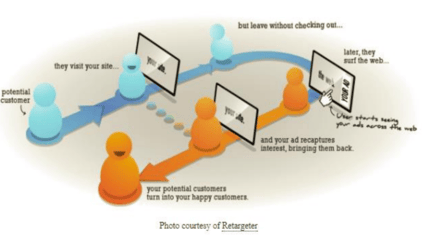Paid advertising is a term heard almost daily in the digital marketing world; however, for many it still remains a mystery. In this article, we will be briefly be exploring the concept of paid ads along with 6 advertising types you can leverage in your next campaign.

But before digging any deeper let's begin by looking at the size and scope of paid ads.
From a study carried out by Recode, paid ads have been rapidly increasing in size, ultimately overtaking television ad spending, which up until that time was the reigning king.
We're not talking about a few million but over two hundred billion dollars in 2017 alone, that's almost double what it was three years ago.
Side note: Take a moment to think about the size of Facebook and Google. It is in part due to their ability to monetize ad spending.
So let's break down this concept and shed some light on the challenges and potential solutions for the mystery known as Paid Advertising.
Objective & Targeting
Just like any business strategy, paid ads need to be supported by a clear objective and KPIs, but oftentimes this is not the case. Most often, the objective is being overlooked because so much more emphasis is given on the budget.
A company might have X amount of dollars that they need to spend during Y amount of time, so the outcome is just translated to action without a specific goal.
In addition to having a specific goal, you also need to have a clear understanding of who you are trying to connect with when spending these advertising dollars.
Let's say you're a hotel in the Bahamas and want to target people that want to go on vacation there. Your ads can't be too general and target people who simply want to 'go on vacation'. This will lead to the ads being ignored and your company just wasting money with few to no results.
The takeaway:
- Begin with a plan
- Set specific, attainable, and measurable goals at the start of your campaign
- Carefully plan out budget allocation,
- Focus on appropriate paid keywords that target your audience perfectly
- Pick the right ad type and platform
So, having understood the core concept of paid advertising, what are the 6 types we can leverage for our next campaign?
1. Display Ads

As you already know, these types of ads appear on third party websites, such as Google Display Network. These third party sites allow for demographic, geographic, contextual, and behavioral targeting, all of which help you target the audience that would be interested in your product or service.
At this point, it would seem like a "no-brainer" to invest in display advertising, but there is a downside... It’s easier to get struck by lightning, rather than to get someone to click on your ad. Needless to say, the ROI can be pretty low for display ads.
So why do people still use them? Because they are usually very affordable, especially when compared to some other ad types on the list.
Here are some options for display ads you might want to consider:
- Static Images: These are the most common type of banner ads; basic with contextual advertising capabilities.
- Text Ads: These ads are made by algorithms to make the ad relevant to the surrounding content on the third party site.
- Floating Banners: These ad types move across the screen and can float above the website’s content. While they are impossible to miss (nearly guaranteeing the viewer will see it,) they can also be a bit annoying.
- Wallpaper: Such ad types appear in and alter the appearance of the entire background of the site, filling the entire page. These are somewhat less intrusive.
- Popup Ads: These are new windows that appear in front of the website’s content, and when clicked, lead to a new window.
Remember, before picking the type of display ad you will be using, be sure to have a good understanding on how each one converts, and have a thought out approach on how you will be leveraging each type moving forward for optimal results.
2. Search Engine Marketing Ads
These types of ads are what people are most familiar with. They are found on search engines such as Google or Bing, and are also known as PPC ads or pay-per-click ads, because that is essentially how they work; you pay a fee each time a visitor clicks on your ad.
This ad type is based on keywords, where you and your competitors bid for the use of the keyword through the search engines. The ROI potential for these ads is among the higher ones on the list, but that’s in terms of clicks (people will see the ad and they will click on them). In terms of actual profit, we can’t say for certain this is the most profitable method as there is a lot more that goes into SEM advertising than just proper ad placement on the page to determine their overall profitability.
There are two options you can choose from when performing SEM advertising:
- PPC: We briefly mentioned this before; you get charged only when someone clicks on the ad. It is also the easiest to track, so monitoring performance and making adjustments is easy and straight forward.
- CPM (cost per thousand): Here you are billed a flat rate for every 1000 impressions. While these ads are easy to budget for and have pretty good branding potential, there is risk for overspending because they are not tied to a specific action, they are only tied to getting an impression. So be very careful here to avoid paying for wasted results if no one clicks.
3. Video Ads
Video ads have been increasing in popularity in recent years as they align well with the limited attention span of today’s internet surfers.
Such ads are most popular on YouTube, but can also appear on third party websites. Rates often vary from site to site (and there is also the cost of creating and running). In terms or ROI, these ads have great potential, but again strategic thinking is required to fully leverage their strength. While you don’t really need to have video creation expertise to run such ads, you do need a video, and you do need to know where to place and how to add conversion capabilities to said video.
There are three options to choose from for video advertising:
- In-Stream Ads: These are the ads that play within the player, and can either appear before (pre-roll), during (mid-roll), or after (post-roll) a piece of video content.
- Out-Stream Ads: These ads will run even if the web page does not have video content. Such ads play when a visitor interacts with the page.

- In-Banner Video Ads: This one is pretty self explanatory. Instead of having a static snapshot, you can have a video in place of a banner.
4. Social Media Ads
These are ads that can run on Facebook, Twitter, LinkedIn, Instagram, and any other social platform that exists today. In terms of ROI potential, these ads are all over the place.
If you have a proper strategy and are targeting your audience properly, the ROI potential is very high. This however can be challenging for many, and without the proper approach we might just be wasting money while our message gets drowned in the sea of social posts.
In terms of being most prolific, Facebook and LinkedIn advertising are possibly the ones that perform the best, with Twitter and Instagram coming in right after.
5. Native Ads
These ads are extremely popular because they allow someone to place their ad in front of someone else's (targeted) audience. Theoretically, this should provide amplified awareness from an ideal audience to the ad.
In terms of ROI potential, again it varies in terms of strategy, target audience precision, and placement.
The three options for native advertising are:
- Sponsored posts: These are ads which are 'hidden in plain sight' in content. For an example, Airbnb posted an article on the New York Times, promoting content about Ellis Island. At the end of the article, Airbnb has a CTA to book a location. You can see the article here.
- Promoted listing: Similar to sponsored posts, but these listings are not content-specific. These are products or services promoted in identical fashion to non-sponsored products.
- Sponsored social media ad: These are ads promoted by influencers on their channel. The posts typically align with the content an influencer publishes.
6. Retargeting Ads
This is a form of online advertising. that can help you keep your brand in front of bounced traffic after they. leave your website. The good thing here is that your ads are served only to those who have already visited your site, and are therefore more likely to be interested in what you have to offer. This is precisely why these ads have such good ROI potential. Finally, these ads have the ability to be used on a plethora of platforms including Google and Facebook.

And there you have it, a brief overview of the six most commonly used paid advertising forms for you to leverage. Before we go, we would like to share one last thing.
The infographic below was created by Invesp and it can work as a great all around checklist or quick summary on everything you need to know about a Paid Advertising Campaign.

Is there anything you think we missed? Are there any points you want us to elaborate on? Let us know!
As always, feel free to check out the links below for more digital marketing insight:
- What Is Native Advertising? (We Had An Expert Tell Us!)
- Quick Guide to Advertising on Social Media Platforms
- Is Native Advertising Impacting Contact Marketing Services?
- 67 Things You Need to Know When Creating a Facebook Ad Campaign





